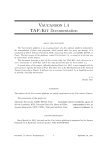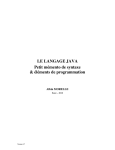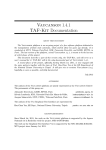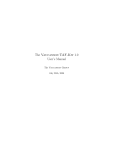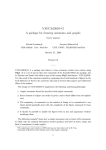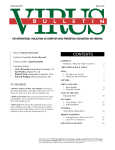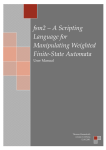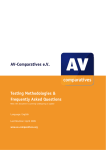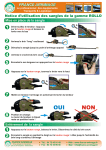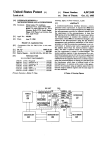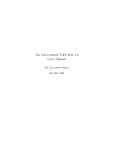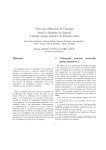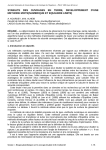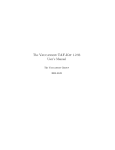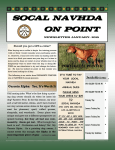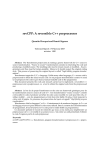Download Release notes for Vaucanson - LRDE
Transcript
Release notes for Vaucanson Contact: [email protected] This document describes major updates to the Vaucanson project. Vaucanson 1.1 • XML – New XML Parser (SAX implementation) With New XSD. – Parser doesn’t omit transitions with bad label anymore instead of failing • Algorithms – eps removal sp(a); Various optimizations. • TAF-Kit – Timer has been improved. – Intern pipe can now be used: ./vcsn-b identity ab.xml | product b.xml - is equivalent to ./vcsn-b identity ab.xml | ./vcsn-b product b.xml - Vaucanson 1.0a, June 13th, 2007 • Documentation – The Doxygen documentation is now installed expanded, rather than compressed. • Algorithms – – – – eps removal sp(a); New generic epsilon removal algorithm based on shortest path. minimize(a); Various optimizations. transpose(a); Transition labels are now transposed too. image(a, b) and domain(a, b); they replace output projection and input projection. These algorithms work for both FMP transducers and RW transducers. • XML – Bug fixes. – I/O optimizations. • Utilities – Lib VCSN Provides C++ libraries for the main automaton types. – SWIG Fix compilation issues. • TAF-Kit – The option --bench relies on iterations of --report-time to benchmark the algorithms. 1 Vaucanson 1.0, July 28th, 2006 • XML. – Many bug fixes, for instance, the alphabet is no longer filled with the default range if it is said to be empty. – Nodes like <label type> are renamed to <labelType>, so as to conform to XSD coding style. – VCSN XSD PATH is no longer used. The environment variable VCSN DATA PATH should point to the Vaucanson data directory, containing, among others, the vaucanson.xsd file. – vaucanson.xsd is no longer looked for in the current directory. – transcode (s); Overloaded function. Convert a std::string (respectively a char) into XML. • TAF-kit. – The new binaries vcsn-z and vcsn-tdc are toolkit to work with Z automata and FMP transducers. – Many commands (algorithms) have been added in vcsn-b. • Algorithms. – is ambiguous(a); Test if a is ambiguous. – trim here(a); Trim the automaton a. – sub normalize here(a); Sub-normalized the automaton a. – invert(t); Return the inverse of the RW transducer t, i.e. the transducer that performs the invert rational relation. – u compose(a): Composition for boolean transducers that keeps the same number of paths. • Renaming and minor additions. – Support::operator* simplifies the writing for one-letter supports. Instead of *e.supp().begin(), write *e.supp(). – The closure functions were renamed as eps removal, since that’s what they actually do. – The macros for each are now called for all. – normalized composition functions are now called compose. – The automaton library is installed with make install. • Layout. The layout of the sources was changed to match the layout of Vaucanson when installed. – vaucanson.xsd is now is the data/ directory. – The automaton library is now split by type. See data/b and data/z. The generators used there are nice demo programs. – VaucanSWIG is at the top level. – demos/utilities/* has been moved into demos/. • This release was made and coordinated by: – Akim Demaille – Florent Terrones – Guillaume Lazzara 2 – Guillaume Leroi – Jacques Sakarovitch – Matthieu Varin – Michaël Cadilhac – Robert Bigaignon – Sylvain Lombardy Vaucanson 0.8 May 15, 2006 • TAF-Kit. The Typed Automata Function Kit of Vaucanson (TAF-Kit). This is a packaging through binary programs of the main algorithms of Vaucanson. In this release, only the Boolean semiring is supported. See the related documentation for help. • Documentation. A first user’s manual for TAF-Kit has been introduced. The Doxygen documentation has been reworked. • XML system. The XSD file has been extended to express transitions as XML trees. The XML proposal has been completly reworked. The XSD file path can now be set by either the environment variable or the CPP macro VCSN XSD PATH. It is also automatically checked in the share directory where this file would be installed on make install. • Renaming. The following renaming have been made: – edge is now transition, – new * functions are now make *, – origin of and src of are now aim of and dst of, – for each loops have been changed to for all, for consistency with STL for each that uses functor. • Delta functions. Delta functions, used to extract the successor states or edges of a state, can now take functor with the deltaf methods of an automaton. If the operator() of the functor returns Booleans and an application of the functor returns false, the loop over all successors is stopped. • Benchmarks. Some Vaucanson benchmarks were added to the distribution. Feel free to make your bench results and please send us them! • Bug fixes. Many bugs have been fixed in the core library and some algorithms have been cleaned. • This release was made and coordinated by – Akim Demaille 3 – Florent Terrones – Guillaume Lazzara – Guillaume Leroi – Jacques Sakarovitch – Matthieu Varin – Michael Cadilhac – Robert Bigaignon – Sylvain Lombardy Vaucanson 0.7.2 November 9, 2005 • Vaucanson works with GNU C++ 3.3, 3.4, 4.0 and ICC 9.0. • Compliance with GCC 4.0 and ICC 9.0. Vaucanson is compliant with the latest version of GCC and ICC, and was successfully tested on Linux and MacOs. • Bug fixes. Some bugs were fixed in the core library, and in the XML system. • XML system. The system now handles geometric attributes in Vaucanson automata. See product algorithm for a sample use. Vaucanson 0.7.1 June 25, 2005 • More algorithms on transducers seen as automata over a direct product of free monoid are available: evaluation, composition covering, composition co-covering, intersection. • A Broken Derived Term automaton algorithm has been added. • Two heuristics for state elimination method algorithm have been added. • src/demos directory has been rearranged: – algorithms : Contains demos of small algorithms. – automaton library : Contains binaries that generate XML samples of various automata. – function library : Contains binaries that call common algorithms available in the library for most of the available predefined types (B, Z, R, (Z, min, +), (Z, max, +), transducers, realtime transducers). – transducers - one rule rewriting : Fibonnaci and One Rule Rewriting demonstration. – utilities - vgrep : grep demonstration. • Some bugs were fixed to ensure library stability. Mainly, algorithms Moore minimization, subnormalized composition, realtime and projection were fixed. • Context headers now include by default all standard algorithms. • All deprecated documentation has been removed. 4 • XML proposal has been changed, and some documentation added. As an example, Boolean automaton that recognize “a+b” is described as follows: <automaton> <content> <states> <state name="s0"/> </states> <transitions> <transition src="s0" dst="s0" label="a"/> <transition src="s0" dst="s0" label="b"/> <initial state="s0"/> <final state="s0"/> </automaton> Note that now <initial> and <final> are children of <transitions>, and the <initials> and <finals> tag are removed. From now on, all files compliant with the previous XML proposal are not compliant with the new proposal. • This version of Vaucanson is released under the GNU General Public Licence. Vaucanson 0.7 May 17, 2005 • Vaucanson works with GNU C++ 3.2, 3.3, 3.4 and ICC 8.1. • Transducers seen as automata over a free monoid product are now available. Until now, transducers in Vaucanson could only be seen as automata with multiplicity in a series. It is now possible to manipulate transducers seen as automata over a free monoid product. – Two context headers have been written: fmp_transducer and z_fmp_ransducer (fmp stands for Free Monoid Product), which can be used in the same way as previous context headers. On top of the classical types defined in all context headers, they define several types needed when manipulating this type of transducers: ALGEBRAIC SETS first alphabet t second alphabet t first monoid t second monoid t ELEMENTS OF SET first monoid elt t second monoid elt t LOW LEVEL MENTATIONS IMPLE- first monoid elt value t second monoid elt value t In addition to that, the contexts provide the user with the following functions: // Create an empty automaton. automaton_t new_automaton(first_alphabet_t, second_alphabet_t); // Create a couple of words that can directly be given to // add_series_edge() for instance. series_set_elt_t make_couple(first_alphabet_t, second_alphabet_t, std::string, std::string); – Some new algorithms have also been added: 5 ∗ fmp_to_realtime and realtime_to_fmp: Enables the user to switch from one view of transducers to another. ∗ normalized_composition: Enables the composition of normalized and sub-normalized transducers seen as automata over a free monoid product. (edges with labels of types (a,b), (1,a) and (a,1)). • New XML I/O system. The former XML system based on a DTD grammar was replaced by a system based on XSD schema specification. The new system is backward-compatible with old XML documents, just change namespace reference to http://vaucanson.lrde.epita.fr and remove DTD node. This new specification comes with full transducer support, and a set of default types for both automata and transducer. To declare a transducer on free monoid product, do as the following: <transducer xmlns=‘‘http://vaucanson.lrde.epita.fr‘‘> <content> <states> <state name=‘‘s0‘‘/> </states> <transitions> <transition src=‘‘s0‘‘ dst=‘‘s0‘‘ in=‘‘a‘‘ out=‘‘b‘‘/> </transitions> <initials/> <finals/> </transducer> To load an automaton (for example on Z semiring) from a stream (containing the XML document), do as the following:: #include <vaucanson/xml/XML.hh> #include <vaucanson/z_automaton.hh> using namespace vcsn; using namespace vcsn::z_automaton; using namespace vcsn::xml; automaton_t a = new_automaton(alphabet_t()); std::cin >> automaton_loader(a, io::string_out(), xml::XML()); To dump automaton as an XML document, do:: #include <vaucanson/tools/xml_dump.hh> ... tools::xml_dump(std::cout, a, "A name"); ... Or use the automaton_saver() function. • Big cleaning in the graph implementation. A lot of superfluous operations were done in the former implementation. Cleaning the code provided huge performance improvement. The actual implementation has the same interface than the former one. • Update context headers. 6 More granularity has been added to context headers. To create one, you need to include desired files from the include/vaucanson/contexts directory in a specific order. Please refer to the sources for more details. • A long-standing bug in the core of the library was corrected. Until now, some compiler optimisation that was believed to happen did not happen. Because of this, all Element instances had an overhead of at least a few bytes in their memory footprint, while in most cases it was not necessary. The code was rewritten to allow for this expected optimisation. • This version of Vaucanson is released under the GNU Lesser General Public Licence. Vaucanson 0.6.1 October 26, 2004 • Vaucanson works with GNU C++ 3.2, 3.3, 3.4 and ICC 8.1. • Vaucanswig is no longer enabled by default. To enable the compilation of Vaucanswig, run: ./configure --enable-vaucanswig Be warned: this compilation takes several hours on a modern computer. • The demos in src/demos/xml were updated. The demo formerly named algorithms is now compiled for various semirings under the following names: b: Boolean semiring. z: usual semiring on Z. r: usual semiring on R. z_max_plus: tropical semiring with (max, +) on Z. z_min_plus: tropical semiring with (min, +) on Z. Furthermore, additional algorithms may be called from this demo: transpose and eval. A list of states may be provided to the aut_to_exp algorithm, thus allowing the elimination of states to be performed in a specified order. An additional src/demo/xml/samples directory was created, with some XML samples, and some programs that can generate XML samples. • expand() definitively replaces verbalize(). The verbalize() function does not exist anymore. It is replaced by expand(), which was introduced in Vaucanson 0.6. A short description of expand() can be found below, in the description of Vaucanson 0.6. • This version of Vaucanson is released under the GNU Lesser General Public Licence. 7 Vaucanson 0.6 July 18, 2004 • Big cleanings in Vaucanson XML. A big work was done around Vaucanson XML, which should be fairly more usable now. To save an automaton in a XML representation, just include vaucanson/xml/static.hh and do: stream << vcsn::automaton_saver(auto, vcsn::io::string_out (), vcsn::xml::xml_loader ()); To reload the automaton, you may do the opposite operation: stream >> vcsn::automaton_loader(auto, vcsn::io::string_out (), vcsn::xml::xml_loader ()); Of course, if you want to get rid of vcsn::io, vcsn::xml, etc. you may do: using namespace vcsn::xml; using namespace vcsn::io; Many more examples and utilities can be found in the directory src/demos/xml. Just browse the sources! • Few more examples. A few programs were written for the CIAA 2004 conference. It is not an extraordinary or complex code, but it demonstrates how quick and easy it may be to use Vaucanson for assembling some algorithms and building simple automata. It may also be a good introduction to learn Vaucanson by practice. These examples are in src/demos/ciaa. • New features in context headers. A new context header for automata over the tropical semiring with the “min” and “+” operators was added. Furthermore, some new functions and typedefs are declared in each header. If you want to use the context “foo”, then include vaucanson/foo.hh. You will get the following types in the namespace vcsn::foo: ALGEBRAIC SETS alphabet t monoid t semiring t series set t automata set t series set t ELEMENTS OF SET monoid elt t semiring elt t series set elt t automaton t rat exp t LOW LEVEL IMPLEMENTATIONS letter t monoid elt value t semiring elt value t series set elt value t automaton impl t rat exp impl t As the user, you will probably only be interested in alphabet_t, automaton_t and rat_exp_t, respectively for alphabets, automata and rational expressions. For transducers, you will get the following extra types: ALGEBRAIC SETS output semiring t ELEMENTS OF SET output semiring elt t 8 LOW LEVEL IMPLEMENTATIONS output semiring elt value t ALGEBRAIC SETS output series set t ELEMENTS OF SET output series set elt t LOW LEVEL IMPLEMENTATIONS output series set elt value t In addition to that, a context provides the user with the following functions: automaton_t new_automaton(alphabet_t); // Create an empty automaton. rat_exp_t new_rat_exp(alphabet_t); // Create an empty rational expression. rat_exp_t new_rat_exp(alphabet_t, std::string); // Create a rational // expression and initialize it. Ex: new_rat_exp(a, "a+b*"); automaton_t standard_of(rat_exp_t); // Build the standard automaton of an exp. automaton_t thompson_of(rat_exp_t); // Build the thompson automaton of an exp. rat_exp_t aut_to_exp(automaton_t); // Build an exp from an automaton. If you want more algorithms, just browse the vaucanson/algorithms directory, or look in the HTML documentation. Currently, the following contexts are available: – boolean_automaton – z_automaton – r_automaton – z_max_plus – z_min_plus – boolean_transducer • Many bug fixes. As usual many bugs were fixed. Especially the quotient should be correct now. There were also some fixes in the standard_of algorithm, and derived_term_automaton now works with expressions that have right weights. The closure was rewritten and should be faster now. Beside from the algorithms a big bug was fixed in the algebra core of Vaucanson, which used to cause some problems when one wanted to use different alphabets in different automata in the same program. Also, rational expressions which weights are implemented as floats or doubles now work correctly. • verbalize() is deprecated, use expand()! A new expand() function was created. It performs a simple expansion of a rational expression. For example: expand(a(a+b)) expand(a(a+b*)) expand(a(a+(a+b*))) expand(a+(a(a+b))*) = = = = aa+ab aa+a.b* aa+a.(a+b)* a+(aa+ab)* To use this function, include vaucanson/algorithms/krat_exp_expand.hh and call the vcsn::expand() function on an Element< Series, rat::exp<M, W> > (or a rat_exp_t if you are using a context). While this function behave exactly as verbalize on series which have a finite support, the latter is deprecated. It will probably be removed in next releases. 9 • krat_exp_print() does not exist anymore. The file vaucanson/algorithms/krat_exp_print.hh was removed. To print a rational expression with no extra parenthesis, just use the << operator onto a C++ stream: std::cout << exp << std::endl; To make this operator behave as in previous versions, send the right format onto the stream: std::cout << setpm (MODE_ALL) << exp << std::endl; (setpm and MODE_ALL are in the vcsn::rat namespace). To have an exhaustive list of the different manipulators and print modes, you may look in vaucanson/algebra/implementation/series/rat/dump_visitor. • tools/usual.hh was removed. A system of context headers is used since vaucanson 0.4.2, and therefore usual.hh became useless. Furthermore it was a bad idea to use it since it has many includes and may slow a lot a compilation. This include has been removed from the distribution. if you were using some of its definitions (e.g. usual_automaton_t) you now need to use the context headers (e.g. include boolean_automaton.hh and use automaton_t in namespace vcsn::boolean_automaton). You will also find all the macros that may be needed in tools/usual_macros.hh. • This version of Vaucanson is released under the GNU Lesser General Public Licence. Vaucanson 0.5 March 24, 2004 • New XML Input/Output system. An XML Input/Output system have been added to Vaucanson. To use it, you will need the Apache Xerces C++ library version 2.3.*. To enable the test suite on the XML I/O system, you need to use the configure option --enable-xml. doc/xml/: You can find a minimal documentation here. xml/: DTD and XSL files and some scripts. include/vaucanson/xml/: Header files. src/test/xml/: Test files. Can be used as examples. • Better documentation. An effort has been made to make the Doxygen documentation look better. The documentation is still incomplete, and some errors probably remain, but it should be far more usable now. Especially, the “Algorithm” section of the documentation should now be exhaustive. • Instantiation of Element which set is dynamic may fail when you do not specify the set. To get more safety at runtime, trying to instantiate an Element which set is dynamic without initializing the set will fail at compile time. This ensures every Element you will manipulate has its corresponding set associated. This has two consequences: – Using Element::set() should provoke no more segmentation faults or similar undesired behavior. – The bound() method has no sense anymore and therefore has been removed. If you make calls to this method in your programs, just consider it returns true every time now and remove the call. 10 • Many renamings. To get a more consistent interface, a few methods have changed. Consequently, your old code designed for Vaucanson 0.4 may not work properly with Vaucanson 0.5. However, converting it to the new nomenclature should be straightforward: – All names containing the word “serie” are now written with “series” instead. For example, serie_get() is now series_get(). – All serie_t typedefs are now series_elt_t. – The method value_get() for the elements of series is now called get(). – The method value_set() for the elements of series is now called assoc(). – The convenience files vaucanson_*.hh in the include/vaucanson directory have been stripped from their leading “vaucanson_”. – hopcroft_minimization.hh is now named minimization_hopcroft.hh to be consistent with minimization_moore.hh. • New implementation for numerical semirings. It is now possible to use rational numbers as an implementation in numerical semirings. In order to do so, the header <vaucanson/algebra/concrete/semiring/rational_number.hh> must be included. All you need to do then, is to declare a variable as follows: vcsn::Element<semiring_t, vcsn::algebra::RationalNumber> q(num, denom); semiring_t can be any numerical semiring. The usual operators have been overloaded, and you can get the integer or double value of the fraction by using to_int() or to_double(). You can also access the numerator with num() and denominator with denom(). • Many more tests. The test suite has been extended and improved. Generic tests are now instantiated on many more types. Also, existing tests have been enriched with extra checks and non-existing tests have been written. Some bugs have been discovered, fixed, and now have their corresponding regression test. As a result, running “make check” should take more time than before, but now trusting a successful check sequence is less hazardous. Note that it is still possible to disable some tests by removing the test directory and running the configure script again. Tests have shown that using some rational expressions which weight are implemented with double can be potentially dangerous. This requires more checks before we can fix it. For the moment try to avoid doing that. • Rewriting of the minimization_moore() algorithm. The minimization algorithm named minimization_moore() has been rewritten. It should be more readable and more reliable now. • This version of Vaucanson is released under the GNU Lesser General Public Licence. Vaucanson 0.4 October 29, 2003 • Addition of an automata I/O subsystem. • Nearly-complete SWIG bindings for algorithms in Vaucanswig. • Preliminary documentation for Vaucanswig. 11 • Addition of a Bitset class which behave almost like a std::set<int>. • Addition of a Window class to permit easy text manipulation. • Addition of a generic search algorithm able to skip characters in the input stream. • This version of Vaucanson is released under the GNU Lesser General Public Licence. Vaucanson 0.3 July 11, 2003 • More documentation. • Addition of SWIG modules (Vaucanswig). • Noticeable performance boost thanks to a working unification of references to structural elements. • This version of Vaucanson is released under the GNU Lesser General Public Licence. Vaucanson 0.2 July 02, 2003 • First public release. • Rewrite of the fundamental module. • New graph structure to replace the old, legacy ManyLinks implementation. • Rewrite of most algorithms. • Implementation of algorithms on rational expressions. • Initial Doxygen documentation efforts. • This version of Vaucanson is released under the GNU Lesser General Public Licence. Vaucanson 0.1 January, 2002 • Initial release. • This version of Vaucanson is released under the GNU Lesser General Public Licence. 12












